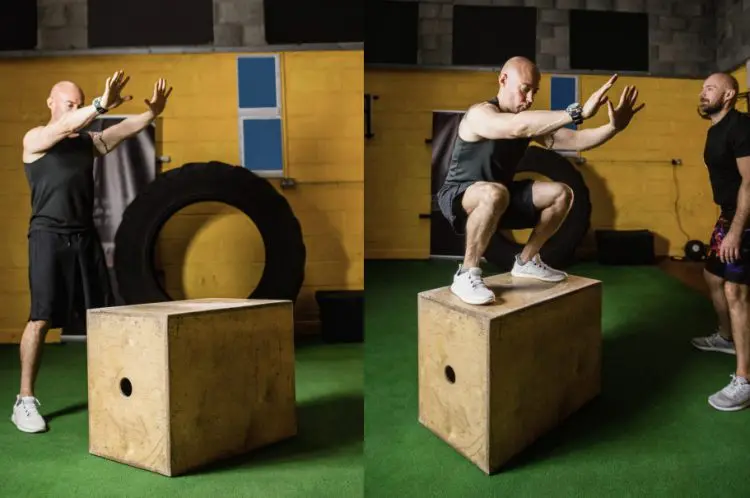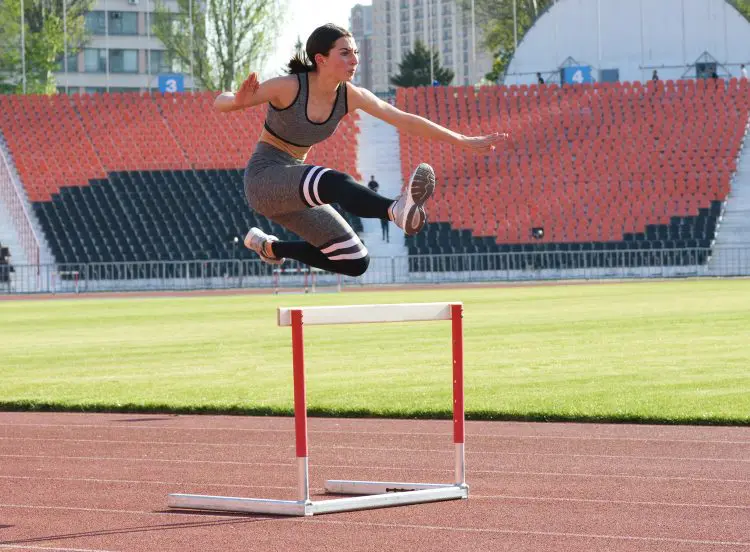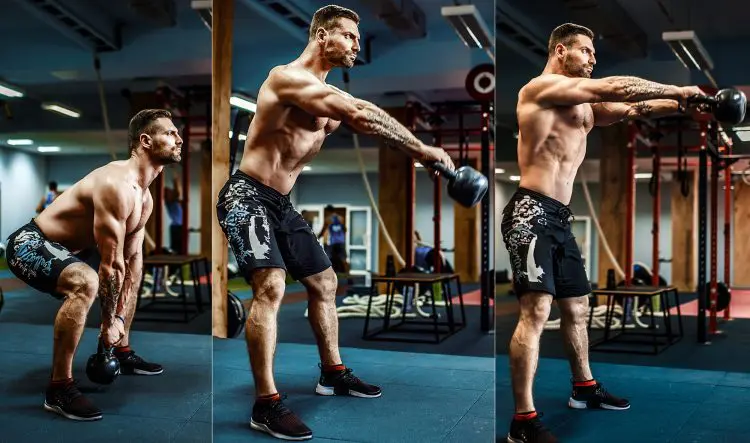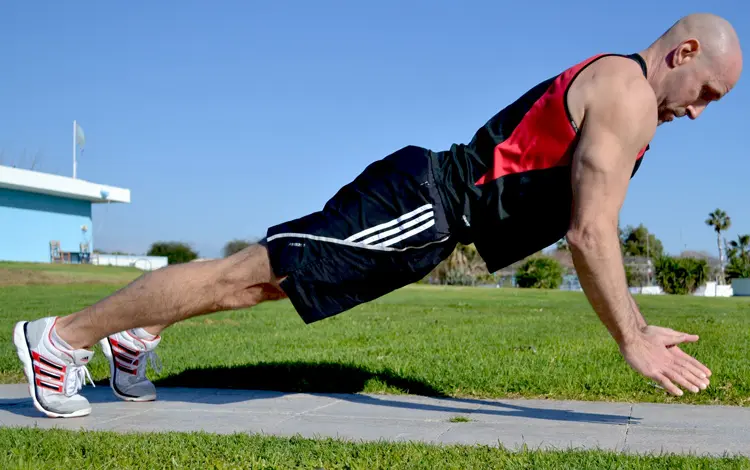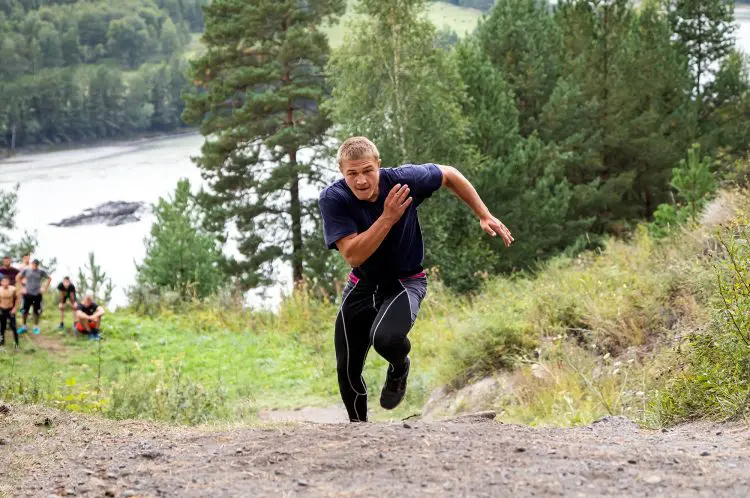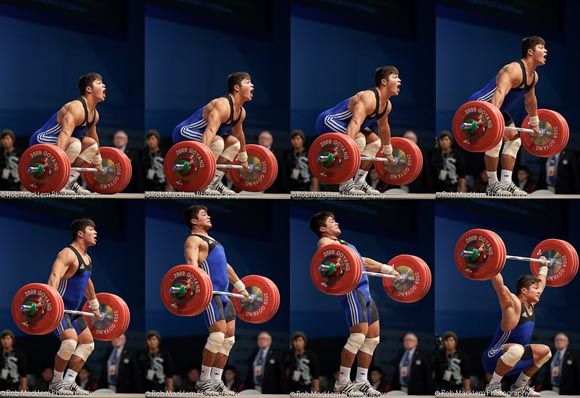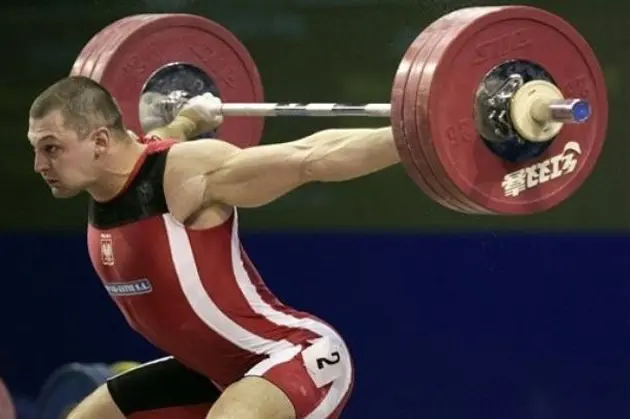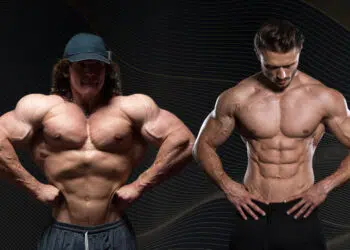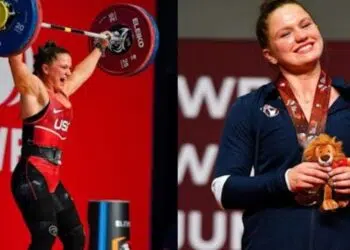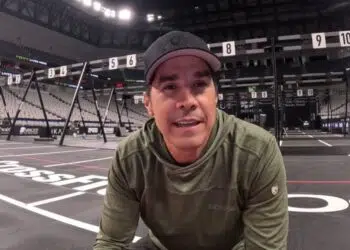Muscle power is critical for optimal performance in sports or if you want to be as physically capable as possible. Power is the ability to generate force quickly and is also known as explosive strength.
To understand power, think about doing a heavy squat and a squat jump, where you try to jump as high as possible. A heavy squat involves a lot of force, but that force is generated relatively slowly. If you’ve ever done a really heavy squat, you know it can take several seconds to grind out a rep.
In contrast, power is generated almost instantly. When you jump, you have to jump fast to break the pull of gravity and explode into the air. Try jumping slowly, and you’ll soon see that it’s not possible. The same applies to kicking, punching, throwing, and other explosive activity.
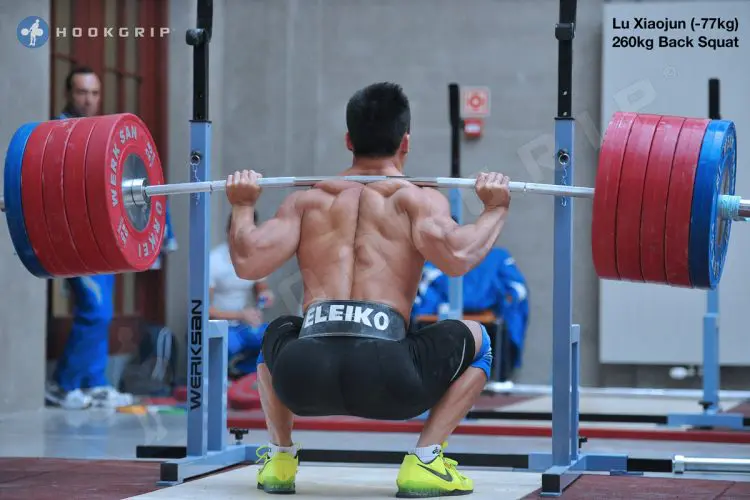
Power, like strength, is a trainable fitness component, and the right exercises can greatly impact your performance.
With over three and a half decades of hands-on experience as a seasoned personal trainer, my expertise lies in collaborating with elite athletes to optimize their power output, ensuring they reach their peak performance potential.
In this article, I share the 12 best power exercises that aren’t Olympic lifts and are suitable for people of varying experience levels.
Level Up Your Fitness: Join our 💪 strong community in Fitness Volt Newsletter. Get daily inspiration, expert-backed workouts, nutrition tips, the latest in strength sports, and the support you need to reach your goals. Subscribe for free!
Recent Updates: On July 16, 2024, Fitness Volt’s Senior Editor Vidur Saini (American Council on Exercise-CPT) updated the article and added actionable expert tips throughout the piece to improve the reader experience.
12 Best Power Exercises That Aren’t Olympic Lifts
Before trying any of these exercises, you must prepare your body and mind for what you are about to do. To be effective, any power exercise must be performed explosively and with maximum effort. Needless to say, this puts a lot of stress on your muscles, ligaments, and joints.
Spend a few minutes warming up by doing some light cardio, followed by dynamic flexibility and mobility exercises for the body parts you are about to use. Finish your warm-up by doing a few easy sets of a strength exercise that uses the same movement pattern as the power exercise you are going to do. For example, if you’re about to squat jumps, do some regular squats to ensure you are as prepared as you can be for your coming workout.
- Squat Jumps
- Box Jumps
- Hurdle Jumps
- Lateral Jumps
- Dynamic Effort Squats
- Kettlebell Swings
- Sumo Deadlift High Pull
- Push Press
- Plyometric Push-Ups
- Medicine Ball Slams
- Medicine Ball Rotational Throws
- Hill Sprints
1. Squat jumps
| Sets & Reps | Equipment Needed | Target Muscles |
| 3 x 8-12 | Bodyweight | Quadriceps, Gluteus Maximus, Hamstrings, Calves |
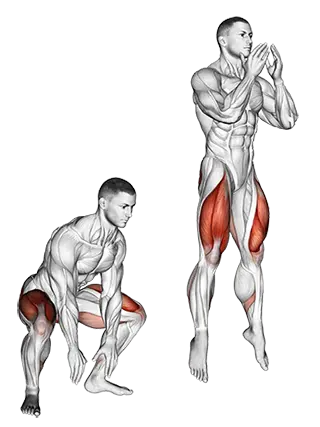
Where squats are one of the best ways to develop lower body strength and muscle size, squat jumps are one of the best ways to develop lower body muscle power.
Squat jumps can be done with just your body weight for resistance or using a barbell or dumbbells. Note that, as the weight increases, so too does the impact on landing. This could increase your risk of injury.
“Squat jumps are not just for athletes,” said Saini. They’re a phenomenal way for anyone to improve their vertical jump and overall explosiveness in daily life.
Pro Tip: As you land, imagine pulling yourself back down into the squat position rather than letting gravity take over. This eccentric loading will boost power development.
| Difficulty | Beginner |
| Progression | Jump squats with greater height, Weighted jump squats |
| Regression | Air squats |
2. Box jumps
| Sets & Reps | Equipment Needed | Target Muscles |
| 3 x 6-8 | Plyometric Box | Quadriceps, Gluteus Maximus, Hamstrings, Calves |
If you want to do squat jumps but are put off by the potentially injurious landing impact, this is the exercise for you. With box jumps, you leap high into the air but then land on a raised platform. You then step back down and go again without having to worry about hammering your joints.
The higher the box, the more powerfully you’ll need to jump. However, you should never use a box that is too high for your jumping ability because a missed jump can really hurt. Like squat jumps, you can do this exercise using just your body weight for resistance or a barbell or dumbbell.
Saini explains that mastering box jumps isn’t just about height — it’s also about landing softly and controlling your descent, which is crucial for joint health
How to do it:
- Stand a few feet behind a sturdy box. Make sure it will support your weight and won’t tip over when you land on it.
- Bend your legs and descend into a quarter to half-depth squat. Swing your arms behind you.
- Using your arms for extra momentum, leap forward and up onto the top of your box.
- Step down and repeat.
- You can jump down if you wish, but this increases the impact. Stepping down is much easier on your joints.
Pro Tip: Focus on a point slightly above the box to ensure a full hip extension at the top of the jump, maximizing power output and minimizing the risk of injury.
| Difficulty | Intermediate |
| Progression | Higher box, Single-leg box jumps |
| Regression | Step-ups |
3. Hurdle jumps
| Sets & Reps | Equipment Needed | Target Muscles |
| 3 x 6-8 | Hurdles | Quadriceps, Gluteus Maximus, Hamstrings, Calves |
Hurdle jumps involve rapid muscle loading followed by an even more rapid muscle unloading. This is called plyometric training. Plyometrics is a very specific and demanding type of power exercise designed to overload muscles and trigger the stretch reflex.
The stretch reflex occurs when a muscle is stretched very fast and responds with a powerful contraction in the opposite direction. Plyometrics is a very useful training method but should be used with caution because it invariably involves a lot of impact.
Saini adds that hurdle jumps teach your body to react quickly and adjust mid-air, improving agility and coordination in unpredictable situations.
How to do it:
- Set out a series of hurdles with enough space between them so you can jump straight from one to the next. About 4-6 hurdles should be enough; more means you will tire and be unable to maintain maximum jumping height.
- Doing a two-footed jump, leap over the first hurdle and land on slightly bent knees. Without pausing, jump over the next hurdle. Try to transition from landing to jumping all but instantaneously, like a bouncing ball.
- You can also do hurdle hops instead of jumps to work one leg at a time.
Pro Tip: Drive your lead knee high as you clear the hurdle, then quickly cycle your legs to minimize airtime and maintain momentum.
| Difficulty | Intermediate |
| Progression | Higher hurdles, Single-leg hurdle hops |
| Regression | Hurdle step-overs |
4. Lateral jumps
| Sets & Reps | Equipment Needed | Target Muscles |
| 3 x 10-12 (each side) | Bodyweight | Quadriceps, Gluteus Medius, Adductors, Abductors |
A lot of sports involve lateral changes of direction, for example, dodging an incoming tackle or zigzagging around a defender. Changing direction at speed is a skill, but it’s also a test of power. It involves turning a forward movement into a sideways one, and that’s a whole to of forces to deal with.
Lateral jumps work your entire lower body with an emphasis on your abductors or outer thighs, which are the muscles mainly responsible for sideways movements.
Don’t underestimate lateral movements, highlights Saini. They strengthen often-neglected muscles that contribute to stability and prevent knee injuries.
How to do it:
- Place a low hurdle on the floor and stand next to it sideways. Bend your knees and descend into a quarter to half-depth squat. Swing your arms across the front of your body and away from the hurdle.
- Using your arms for extra momentum, jump sideways over the hurdle. Focus on lateral movement as much as you do the height of your jump.
- Land on slightly bent knees and then jump back over the hurdle.
- You can hop instead of jump to work one leg at a time.
Pro Tip: Land softly with slightly bent knees to absorb impact, and immediately drive off the planted foot to maintain a continuous rhythm and challenge your lateral power.
| Difficulty | Beginner |
| Progression | Lateral jumps over obstacles, Weighted lateral jumps |
| Regression | Lateral shuffles |
5. Dynamic effort squats
| Sets & Reps | Equipment Needed | Target Muscles |
| 5 x 3 | Barbell | Quadriceps, Gluteus Maximus, Hamstrings, Erector Spinae |
If just thinking about all these jumping exercises makes your knees ache, you’ll be glad to hear that you can modify your regular squat workout to make it more power-specific.
The dynamic effort (DE) method comes from powerlifting and is a viable alternative to impactful jumping exercises.
Saini suggests that these squats are a game-changer for powerlifters looking to break through plateaus and develop lightning-fast bar speed.
How to do it:
- Load up the bar with about 50-60% of your one-repetition maximum (1RM)
- Rest and hold the bar across your upper back, and not your neck. Adopt your normal squat stance, feet between shoulder and hip-width apart, toes turned slightly outward. Brace your abs.
- Descend under control and then, on reaching the bottom of your rep, explode upward and stand up as fast as you can.
- Reset your core and repeat.
- This method works best with 2 to 3-rep sets.
- You can also use the DE method with deadlifts to work your posterior chain or bench presses and overhead presses to work your upper body.
Pro Tip: Focus on accelerating the bar explosively throughout the entire concentric phase, even as the weight gets heavier. This trains your nervous system for maximum power output.
| Difficulty | Advanced |
| Progression | Increased weight |
| Regression | Tempo squats |
6. Kettlebell swings
| Sets & Reps | Equipment Needed | Target Muscles |
| 3 x 15-20 | Kettlebell | Gluteus Maximus, Hamstrings, Erector Spinae, Core, Lats, Shoulders |
Kettlebell swings, especially when done with a heavy weight, are a straightforward but useful power exercise. Like cleans and snatches, swings involve an explosive posterior chain contraction, but they are much more accessible as they don’t require bumper plates or a liftering platform.
Don’t have a heavy enough kettlebell? You can also do swings with a single dumbbell instead.
Saini says that the kettlebell swing is the king of hip-hinging exercises. It’s a full-body movement that torches calories and builds a rock-solid posterior chain.
Pro Tip: The power of the swing comes from the hips, not the arms. Imagine snapping your hips forward like a rubber band to propel the kettlebell upward.
| Difficulty | Beginner |
| Progression | Heavier kettlebell, Single-arm swings |
| Regression | Kettlebell deadlifts |
7. Sumo deadlift high pull
| Sets & Reps | Equipment Needed | Target Muscles |
| 3 x 8-12 | Barbell | Glutes, Hamstrings, Trapezius, Shoulders, Core |
The sumo deadlift high pull works the same muscles as cleans and snatches, but it’s considerably easier to learn. And, as you don’t drop the weight, you won’t need a lifting platform and bumper plates either.
CrossFitters tend to do this exercise using light weights for high reps, which is an excellent way to develop muscular endurance and fitness. However, you can also do this exercise with heavy weights for low reps to increase explosive power instead.
Level Up Your Fitness: Join our 💪 strong community in Fitness Volt Newsletter. Get daily inspiration, expert-backed workouts, nutrition tips, the latest in strength sports, and the support you need to reach your goals. Subscribe for free!
Saini adds that this lift combines the power of a deadlift with an explosive shoulder shrug, making it a potent tool for developing upper body strength and coordination.
Pro Tip: Drive your hips forward and shrug your shoulders simultaneously as you pull the bar upward, creating a powerful, synchronized movement that targets multiple muscle groups.
| Difficulty | Intermediate |
| Progression | Increased weight, Power clean |
| Regression | Sumo deadlift |
8. Push press
| Sets & Reps | Equipment Needed | Target Muscles |
| 3 x 6-8 | Barbell | Shoulders, Triceps, Quadriceps |
Few exercises are as effective as the split jerk when it comes to building upper body power. In Olympic lifting, split jerks allow lifters to hoist huge weights overhead. However, they are also very technical and hard to learn.
Thankfully, there is a similar, simpler exercise you can do that works the same muscles; the push press.
Saini suggests that the push press is a secret weapon for building shoulder strength and stability while engaging the lower body for a full-body power boost.
How to do it:
- Rack and hold a barbell across the front of your shoulders. Your hands should be slightly wider than shoulder-width apart. Stand with your feet between shoulder and hip-width apart, toes turned slightly outward. Brace your core.
- Bend your knees and descend into a quarter-depth squat.
- Stand up explosively and use this momentum to help you drive the weight up and overhead to arm’s length.
- Lower the bar back to your shoulders and repeat.
- You can also do this exercise with dumbbells for variation.
Pro Tip: Dip quickly but under control, then drive upward with your legs and hips before extending your arms. This leg drive is key to maximizing the weight you can press.
| Difficulty | Intermediate |
| Progression | Heavier weight, Jerk |
| Regression | Strict overhead press |
9. Plyometric push-ups
| Sets & Reps | Equipment Needed | Target Muscles |
| 3 x Max Reps | Bodyweight | Chest, Shoulders, Triceps |
“Plyo push-ups are like push-ups on steroids,” says Saini. They enhance your chest and tricep strength while training your nervous system for explosive movements.”
You don’t have to use a whole lot of training equipment to develop muscle power. In fact, a lot of power exercises work best when you just use your body weight for resistance. One such exercise is the plyometric push-up, also known as plyo push-ups and clap push-ups.
This is an excellent upper-body power exercise that, provided you have mastered regular push-ups, you can do anywhere and anytime. Be warned: It can be hard on your hands and wrists, so skip this exercise if you have problems with either.
How to do it:
- Adopt the push-up position with your hands about shoulder-width apart, arms straight, and shoulders, hips, and feet aligned. Brace your core.
- Bend your arms and lower your chest down to within an inch of the floor.
- Immediately extend your arms as powerfully as you can, pushing your upper body off the floor. Clap your hands if you wish.
- Land on slightly bent arms, descend, and repeat.
- You can also do this exercise on your knees to make it easier.
Pro Tip: Focus on pushing off the ground with enough force to briefly leave the ground, then catch yourself softly to avoid wrist strain. This trains the fast-twitch muscle fibers responsible for explosive power.
| Difficulty | Intermediate |
| Progression | Clapping push-ups, Depth push-ups |
| Regression | Regular push-ups |
10. Medicine ball slams
| Sets & Reps | Equipment Needed | Target Muscles |
| 3 x 8-12 | Medicine Ball | Core, Shoulders, Triceps, Lats |
Where most power exercises involve pushing movements, this one involves more of a pulling motion. It works your lats, abs, and hip flexors, and all you need to do it is use a heavy medicine ball.
Don’t use a gel-filled ball as they are prone to bursting, and make sure your floor is strong enough that you won’t damage it.
“Don’t just slam the ball—focus on using your core to generate power from your hips, making each slam a full-body exercise,” cues Saini.
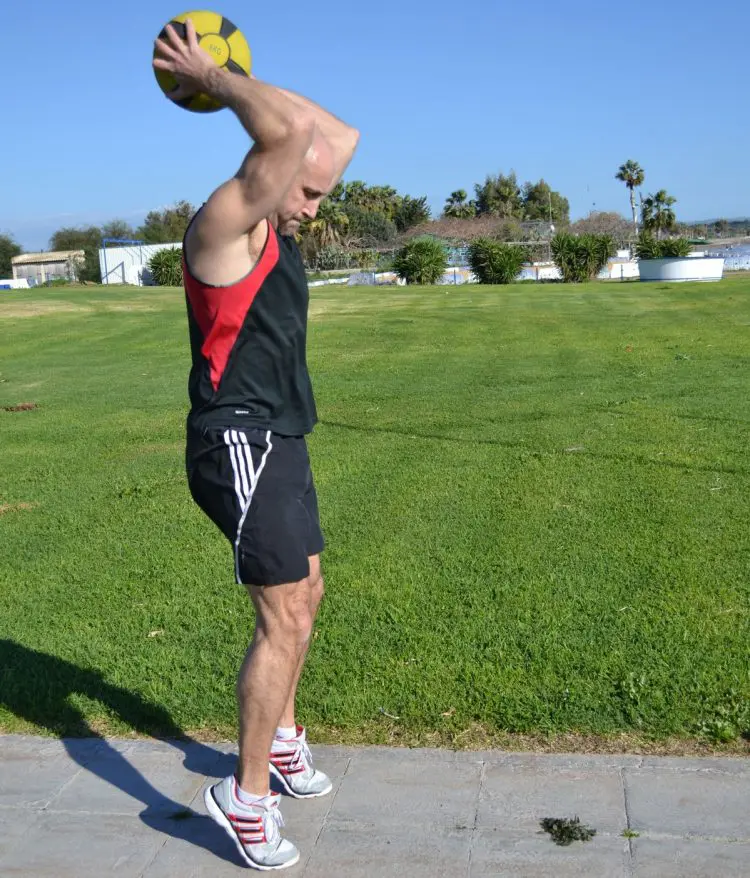
How to do it:
- Stand with your feet about shoulder-width apart. Hold a medicine ball in your hands.
- Lift the ball above your head and then hurl it down at the floor just in front of your feet as hard as you can. Use your whole body and not just your arms. Try and drill that ball through the floor.
- Catch the ball as it rebounds and then repeat.
Pro Tip: Engage your core throughout the entire movement, from the initial lift to the final slam. This will protect your spine and generate more power from your core muscles.
| Difficulty | Beginner |
| Progression | Heavier medicine ball, Overhead medicine ball slams |
| Regression | Medicine ball squat throws |
11. Medicine ball rotational throws
| Sets & Reps | Equipment Needed | Target Muscles |
| 3 x 10-12 (each side) | Medicine Ball | Obliques, Core, Shoulders |
Most power exercises take place in the sagittal plane. However, in sports, many power movements involve rotation, such as kicking, punching, and throwing.
While general power exercises are always beneficial, more specific exercises could help more. This exercise is all about rotation, and it’s excellent for anyone who plays sports like tennis, soccer, football, golf, or hockey.
Saini explains that this exercise is a must-have for rotational athletes like golfers or baseball players, but it’s also beneficial for anyone looking to strengthen their core and improve spinal mobility.
How to do it:
- Stand sideways on to a sturdy wall. Hold your medicine ball in both hands.
- Twist your upper body away from the wall to “wind up” and then turn toward the wall and release the ball.
- Catch the ball as it bounces back and then repeat.
- Move further away from the wall and use a heavier medicine ball to make this exercise harder.
Pro Tip: Rotate explosively from your hips and core, not just your arms. Use your obliques to generate power and transfer it through the medicine ball.
| Difficulty | Beginner |
| Progression | Heavier medicine ball, Standing rotational throws |
| Regression | Russian twists |
12. Hill sprints
| Sets & Reps | Equipment Needed | Target Muscles |
| 6-8 sprints | Hill/Incline | Full Body |
Sprinting is one of the most common tests of power in sports. You can also use sprinting to develop power, especially in your posterior chain.
Sprinting on flat ground is a useful exercise for building power, but hill sprints are arguably better. Sprinting uphill increases the overload on the target muscles and is also easier on your joints.
Saini adds that hill sprints are a low-impact way to improve cardiovascular fitness, build leg strength, and burn a ton of calories in a short amount of time.
How to do it:
- Find yourself a steep hill that’s between 20-50 yards long. Start a few yards back from the bottom of your hill and jog toward it.
- Accelerate as you hit the bottom of the hill. Lean forward, pump your arms, and drive your legs back.
- Power up the hill as fast as you can. If you find yourself slowing down before you reach the top of your hill, it’s too long, and you should use a shorter one or stop sooner.
- Walk back down the bottom, rest a moment, and repeat.
Pro Tip: Lean slightly forward and pump your arms to maintain balance and power. Focus on driving your knees high and striking the ground with the balls of your feet for maximum propulsion.
| Difficulty | Intermediate |
| Progression | Increased incline, Weighted vest sprints |
| Regression | Flat ground sprints |
Best Power Exercise Workout For Overall Development
Below is a balanced workout suitable for athletes of all experience levels:
| Exercise | Sets | Reps | Rest (minutes) |
| Squat Jumps | 3 | 8-12 | 1-2 |
| Kettlebell Swings | 3 | 15-20 | 1-2 |
| Sumo Deadlift High Pull | 3 | 8-12 | 2-3 |
| Push Press | 3 | 6-8 | 2-3 |
| Medicine Ball Slams | 3 | 8-12 | 1-2 |
Training For Power: The Olympic Lifts
While some people are naturally more powerful than others, you can also train to improve your explosive strength. For a lot of people, that means the Olympic lifts and their variations, such as squat cleans, power cleans, power snatches, and jerks.
Each of these exercises is done at speed using moderate to heavy weights. They also involve large ranges of motion, and multiple muscles and joints, all of which is what makes them so useful.
But these exercises also have disadvantages, which means you may need an alternative. The drawbacks of the Olympic lifts and their variations include:
Hard to learn
Even power cleans and power snatches, arguably the easiest Olympic lift variations, can be difficult to master. A lot of lifters will require coaching to learn how to do these exercises correctly. Until you’ve got your technique down, you won’t be able to do these exercises with meaningful loads, which means they won’t be very effective either.
Specialized equipment required
The Olympic lifts are all about explosive concentric contractions. In other words, you LIFT the weight as fast as you can. Once lifted, the weight is dropped back to the floor. This means you’ll need a proper weightlifting platform, bumper plates, and an Olympic lifting bar.
Not all gyms have these facilities, and doing the Olympic lifts with improper equipment will damage it, wreck your floor, and could even result in injury.
Risk of injury
Olympic lifters are good at “dumping” the bar if they fail to complete a lift. This often involves jumping out from under the weight as it crashes back down to the platform. This emergency action takes a lot of practice and skill, not to mention bravery too.
Olympic lifters still get hurt missing lifts, and dislocated shoulders are not uncommon. Recreational lifters may not be able to dump the weight safely, meaning the risk of Olympic lifting outweighs at least some of the benefits.
Some gyms don’t allow the Olympic lifts
Some commercial gyms do not permit Olympic lifting. They consider it too dangerous and won’t let you do it even if you know what you are doing. They are probably concerned about potential lawsuits should you a) hurt yourself or b) injure another gym user during your workout.
This doesn’t mean that you SHOULDN’T do the Olympic lifts or their variations. After all, they’re very useful for developing muscle power. But just because these exercises are effective and popular doesn’t mean you have to do them. There are plenty of exercises you can use to develop your explosive strength that are easier to learn and don’t require specialized equipment.
Wrapping Up
Whether you want to increase your strength for sports or just add some variety to your training, power exercises can help. However, while the Olympic lifts really do work, the disadvantages outweigh the benefits for many exercisers.
The good news is that there are lots of exercises you can do that are easier to learn than the snatch and clean and jerk while also providing similar benefits. In some cases, these moves require nothing more than your body weight and some space.
Finally, remember that power training is best done for low to moderate reps using moderate to heavy weights. The aim of the exercise is should always be maximum acceleration and not feeling the burn! With power exercises, workout quality is more important than quantity.

